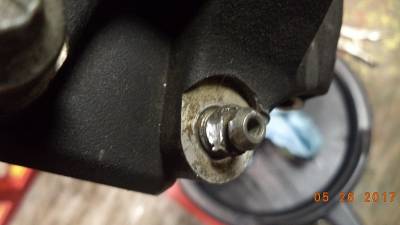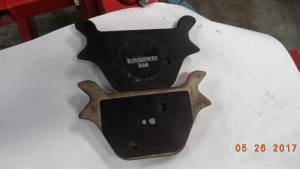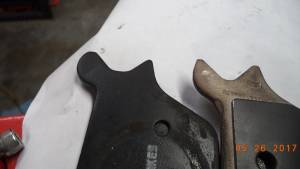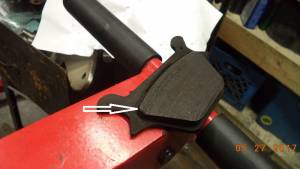Table of Contents
This is an old revision of the document!
REF: Wheels, Brakes & Tires
Sub-Documents
* . . . Next Subject
Brake System
- Brake caliper mounting bolt O-rings- Dow Corning 44 grease (“Pin Lube” in parts kit) 1)
- O.D. of brake caliper piston (including chamfer), caliper piston bore and I.D. of the installed piston seal - Novaguard silicon grease.
- I.D. of upper caliper (threaded) bushing bore, O.D. of threaded bushing, I.D. of upper and lower caliper mounting pin bores - Dow Corning 44 grease (“Pin Lube” in parts kit) 2)
Aftermarket Brake Parts
Aftermarket brakes vs OEM brakes Check fitment of aftermarket brakes before using them. Just because they are published as 'will fit your vehicle' doesn't make it so. The pics below are a comparison of OEM brakes and an aftermarket brand:
The light colored OEM brake has sharper contours to match up to the screw mounting bracket shims it rides against. The aftermarket brand is slightly shorter in length than OEM which allows it to wiggle around a bit since it doesn't fit tight against the screw shims which can allow it to drop below the disc resulting in poor pad wear and possible disc wear or disc drag as in the pic below:
Be sure your brakes can not wiggle around before installing the caliper.
Brake Fluid
HD Recommendations
When to Check or Change Brake Fluid
| Year Model | Check | Change |
|---|---|---|
| 1959-1969 | ||
| 1970-197810) | Every 2,000 miles | Every 5,000 miles |
| 1979-198511) | Initial 500, then every 2,500 miles | Every 2 years |
| 1986-199012) | Check at initial 500 then every 5,000 miles, prior to storage or annually | Change/ Replace as needed |
| 1991 to 200313) | Every 300 til and including initial 1,000 miles, then every 5,000 miles | Replace as needed |
What Type Brake Fluid Do You Have
When in doubt,
- 1st check your bikes service manual to see what should go in it.
- Next, get a few drops of brake fluid from your brake reservoir and put them in a small container. Add a few drops of water and mix it all together.
- If the water mixes with the brake fluid, it is DOT 3, 4 or (5.1).
- If the water does not mix with the brake fluid it is DOT 5. 14)
The Color Check
- DOT 3 is available in Clear, Pale Yellow, Blue & Crimson Red.
- DOT 4 is available in Clear, Pale Yellow & Crimson Red.
- DOT 5.1 is available Clear, Pale Yellow & Blue.
- DOT 5 is available in Purple & Violet. 15)
The presence or absence of color is not a safe criteria to distinguish between the different types of brake fluids. The color is added in brake fluid to detect leaks and color does not effect the quality of brake fluid. Since blue and purple sometimes can seem the same color depending on lighting, you could be mixing Dot 5 and DOT (5.1).
Mixing Brake Fluids
- Mixing different colors of the same type typically won't hurt the system as long as what you are adding to has not been compromised previously if your just topping off your existing fluid.
- You can typically mix DOT 3,4 and 5.1 fluids without damaging your braking system or compromising your existing braking performance. But as nearly every brake fluid manufacturer will state: doing so is not recommended. Why? Mixing good new fluid and old bad fluid means you will retain the bad fluid's performance and change the temperature ratings of your residual fluid. You can't mix any others with Dot 5 fluids. Mixing the others into Dot 5 would cause a meltdown of the rubber parts and/ or a break down of the silicone and possibly clog up the brake lines causing brake failure. Dot 5 into the others may release clogs into the brake lines also leading to brake failure.
- If silicone is introduced into an older brake system, the silicone will latch onto the sludge generated by gradual component deterioration and create a gelatin like goop which will attract more crud and eventually plug up metering orifices or cause pistons to stick. If you have already changed to DOT 5, don't compound the problem and change back. You will never get all of the silicone out of your system. Just change the fluid regularly. For those who race using silicone fluid, crack the bleed screws before each racing session to insure that there is no water in the calipers. 16)
DOT 3, DOT 4, DOT 5.1
- DOT 3 brake fluids are mixtures of glycols and glycol ethers. DOT 4 contains borate esters in addition to what is in DOT 3. These brake fluids are somewhat similar to automotive anti-freeze (ethylene glycol) and are not a petroleum fluid. Both DOT 3-4 and DOT 5 fluids are compatible with most brake system materials except in the case of some silicone rubber external components such as caliper piston boots 17)
- The problem with DOT 3-4 fluids is water absorption. DOT 3-4 glycol based fluids, just like ethylene glycol antifreezes, are readily miscible with water. Long term brake system water content tends to reach a maximum of about 3%, which is readily handled by the corrosion inhibitors in the brake fluid formulation. Since the inhibitors are gradually depleted as they do their job, glycol brake fluid, just like anti-freeze, needs to be changed periodically. 18)
- Fluid boiling point DOT 4 glycol based fluid has a higher boiling point (446F) than DOT 3 (401F), and both fluids will exhibit a reduced boiling point as water content increases.19)
- DOT 5.1 is also glycol-based and it's major difference to Dot 3 and 4 is it's dry boiling point (minimum 518F).
DOT 5
- The change to Dot 5 brake fluid was made with HD production motorcycles in September of 1976 20). It is of silicone chemistry and not being water miscible, it must rely on the silicone (with some corrosion inhibitors) as a barrier film to control corrosion. Water is not absorbed by silicone as in the case of DOT 3-4-5.1 fluids, and will remain as a separate globule sinking to the lowest point in the brake system, since it is more dense. 21)
- When using Dot 3 brake fluid, the brake system should be drained, flushed, and refilled with new brake fluid every year to eliminate any contamination such as sludge. This yearly service was eliminated when D.O.T.-5 silicone fluid was used instead and with improved performance. 22)
- Silicone brake fluid reduces corrosion, will not degrade the “rubber” components, and sludge will not form in the system. It will not absorb water, does not attack painted parts, and has a higher boiling point than conventional brake fluid. When stored under normal conditions it has unlimited shelf life. However, it is somewhat harder to bleed brakes with Dot 5 because of its viscosity. 23)
- Dot 5 in its pure state offers a higher boiling point (500F) however if water got into the system, and a big globule found its way into a caliper, the water would start to boil at 212F causing a vapor lock condition (possible brake failure). DOT 3 fluid with 3% water content would still exhibit a boiling point of 300F. Silicone fluids also exhibit a 3 times greater propensity to dissolve air and other gasses which can lead to a “spongy pedal” and reduced braking at high altitudes. 24)
Brake Fluid Boiling Points
- Dry Boiling Point: This is the temperature that your brake fluid will boil when its straight out of the sealed bottle. When there has been effectively no time for it to absorb any moisture. If you are racing on a track, you are most concerned with this value, since the fluid in your lines is likely to be freshly added. 25)
- Wet Boiling Point: This is the temperature that your brake fluid will boil when its been inside your braking system for a reasonably long time. How long it takes to get to this saturation point will vary by fluid type, but a good rule of thumb is the higher the dry boiling point, the faster the fluid will saturate (an informal sort of standard is…not always - used by fluid manufacturers: the wet boiling point is the reading taken after fluid has been sitting for one year in your brake lines). If you are riding mainly on the street the wet boiling point is going to be the one you want to pay attention to since the fluid will typically stay in your brake lines for an extended period of time. 26)
SAE Testing Brake Fluid Lubricity
- SAE is currently working on modernizing testing and standards for automotive brake fluids. Below are the standards that relate to brake fluid and their corresponding standard number.
- J1703- Motor Vehicle Brake Fluid Jul 20, 2015
- J1704- Motor Vehicle Brake Fluid Based Upon Glycols, Glycol Ethers and the Corresponding Borates Jul 20, 2015
- J1705- Low Water Tolerant Brake Fluids Apr 21, 2014
- J1707- Service Maintenance of SAE J1703 and J1704 Brake Fluids in Motor Vehicle Brake Systems
Links to Brake Fluid Comparison Charts on the Web
- Interesting amateur test on mixing brake fluids http://www.buckeyetriumphs.org/technical/Brakes/Fluid/Fluid.htm
Bleeding Brake Lines
Bleeder Screws
Stripped or Worn Down Hex Head on the Bleeder Valve
This can happen when the wrong size / type wrench is used on the bleeder screw or too much torque was applied. It's best to use a (six point) socket or box end wrench to match the six sided screw. A twelve point wrench, pulled tight, will eventually strip the head.
Next to come out of the toolbox is usually the vise-grip pliers. This works sometimes but, when it doesn't, it will round off the rest of the hex head or break the screw in half.
- You can use a Dremil tool with the metal cutting blade or even a small file and cut / form a flat on two opposite sides of the screw. The heat generated will help and you can then use an open end wrench to remove the bleeder screw.
 |
| Flats cut on two sides of bleeder screw 30) |
Bleeding The Brake System By The Book
Notes:
- When checking the relief port operation:
- Spilling brake fluid on brake pads:
- The MoCo recommendation is “Caution should be used when bleeding because any brake fluid on the pad will contaminate the pad material and reduce brake effectiveness.
The fluid absorbed by the pads cannot be removed satisfactorily with any solvent or by operating the brakes”. 33)
When You Should Bleed The System
- Bleed the hydraulic brake system anytime a brake line, M/C or caliper has been opened.
- Whenever the brake pedal or lever operation feels spongy.
Before Bleeding
Arrange for the master cylinder to be in a level position by standing the bike upright (off the kickstand).
Manually Bleeding
- Install the end of a length of plastic tubing over the caliper bleeder valve. Place the free end of the tube in a clean container.
- Add new brake fluid to M/C until the fluid level is 1/8” (3.2mm) from the top.
- Depress and hold the brake lever / pedal to build up pressure.
- Open bleeder valve about 1/2 turn.
Brake fluid will flow from the bleeder valve through the tubing.
Close the bleeder valve when the lever / pedal has moved 1/2 - 3/4 of it’s full travel range.
Allow lever / pedal to return slowly to its original position. - Repeat steps 2-4 until air bubbles are purged.
- Add fluid and with the cover removed, actuate the lever to check the relief port.
Make sure there is a slight spurt of fluid upward verifying all the internal components are working properly. - Torque the bleeder valve to 80-100 in lbs. (9.0-11.3 Nm).
- Install the cap on the bleeder valve.
- Fill the M/C with new brake fluid to 1/8” (3.2mm) from the top.
- Torque the M/C cover screws:
- Turn ignition on and pump the brake pedal / lever to verify operation of the brake lamp.
- Do a test ride at low speed. Repeat the above procedure if the brakes feel spongy.
XLFORUM Bleeding Advice
- Before attempting to bleed the lines, make sure that the system has been thoroughly cleaned/flushed of all old fluid and any debris. Fill the system/brake cyl bowl with the correct fluid, ensure that the relief port is clear of debris and the brake cylinder piston is fully retracted. 37)
- Rumor has it to take the calipers off to bleed the brakes. There is no reason to do this unless you have a defective master cylinder. Bleeding the lines with the calipers on is the best way to accomplish the chore and to keep from inducing more air or damage to the brake system. Below are some good examples of this.
- If none of these methods work for you, may either have a leaking compression fitting, the cup in the master cylinder is blown out, or the big O-ring in the caliper is not sealing against the piston. Those are the only three places for air to enter the system. 38)
Reverse Bleeding Your Brake Fluid Lines
- The key to this method is a slow push from the caliper to the master cylinder. Too fast and you spit brake fluid all over the bike and the floor.
- The handle end of the master cylinder must be higher than the hose end so the air bubbles will move to the relief port of the master cylinder. 41)
- You can buy the 60 ml irrigation syringe [not an injection syringe] at any drug store, especially one specializing in home medical products. 42)
- Discard the needle from the syringe, remove lid from master cylinder and re-set it on top. It must be off of course, but the master cylinder must be covered to prevent the fluid from squirting 10' across the shop. 43)
- Attach a short clear plastic tube to the end of the syringe. Best to use a tube that is “too small” in diameter - this is important to get a really tight seal on the bleeder to the point you have to force it onto the bleeder with needle nose pliers. 44)
- Use the syringe to empty the master cylinder and discard this fluid. 45)
- Fill the syringe with new brake fluid and let stand for 5 minutes or so for the bubbles to rise out of the syringe / tube. 46)
- Attach to bleeder, hold it upright and fiddle with the tube until air has risen into syringe. 47)
- Loosen the bleeder and slowly squeeze the fluid thru, do not release pressure on the syringe without tightening the bleeder - some fluid and possibly some air may get drawn back. 48)
- Another way to do it is with a vacuum pump. You need to put grease around the threads of the bleed screw first to ensure a solid seal. Hook the vacuum line to the bleed screw, that line goes to a collector jar that has an additional port that goes to the vacuum pump. Pump it up, open the screw, and keep vacuum until it's a steady stream of fluid, then close it off. 51)
- This will still take several tries until you get fluid. Make sure u keep an eye on the bowl and don't let the fluid get to low or u will start to suck air. Once u get fluid, close bleeder and try to pump the brake pedal ..when get pedal…then bleed manual to ensure that all air has escaped. 52)
Force Bleeding Brakes thru the Bleeder Screw
In watching the air bubbles through a clear tube while pumping the brakes with the bleeder valve opened, you will see force both push and pull the air. General rule of thumb should be to push hard, release slow. You push more air farther towards the outlet point when the force is faster. When bleeding at the calipers, the tubing installed on the bleeder screw should be higher than the caliper to allow air to 'want' to go there. Releasing the force (lever or pedal) fast will allow the air to suck back towards the master cylinder at the same speed it was forced out. Releasing at a slow rate will allow more fluid than air to return by the time the lever / pedal stops home. 53)
- One way to bleed the caliper or wheel cylinder is to first top off the master cylinder and then remove the bleed screw completely. 54)
- Plug the bleed screw hole with your finger tightly. Have a friend or you can do it yourself, one at a time, squeeze the brake while holding tightly over the bleed hole. The fluid and air will push past your finger and seal immediately when the brake is released. It's a hell of a lot easier and faster than the opening and closing a bleed screw. You can do both calipers at once this way if you have a helper. Once you have a solid stream of fluid, you are fine. 55) This is exactly what Speed Bleeders do. They take the place of and act the same as your finger would. 56)
- Swap your bleeder screw out for a Speed Bleeder®. 57) It is very simple to install:
- Simply clean the area around the old bleeder screw so that no dirt or contaminants can get into the brake system.
- Remove the old bleeder screw and discard.
- Screw in the Speed Bleeder into the wheel cylinder or caliper until it seats.
- Unscrew the Speed Bleeder 1/4 to 1/2 turn.
- Slowly pump the brake pedal approximately 4-5 times. (You do not have to close the bleeder screw between pumps.) A one way check valve lets the air and fluid out when the pedal is pressed and immediately closes between pumps preventing new air from re-entering the system between pumps.
- After bubble-free fluid comes out of the Speed Bleeder screw, close the bleeder until it seats.
- Proceed to the next caliper until all are bled.
- The Speed Bleeder screw has a check valve inside so it can't suck air at the bottom. They're cheap too! 58)
- Get you a small rubber hose like for the windshield washer on your car about a foot long. You may need to heat it to get it over bleeder valve tip. Put it on bleeder valve place other end in a jar submerged in brake fluid I use a jar with a lid and punch a hole the size of the hose this keeps the hose from coming out the fluid in the jar. As you pump the brake and let off the only thing it can pull back is bf. The air goes out the fluid in jar. Do this awhile and you'll see no more air bubbles coming from jar close bleeder and your good to go. Make sure to not let master cylinder go dry while doing this. 59)



